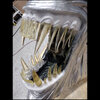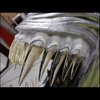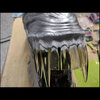Yesterday was teeth installation day!
Here is a picture of the inside of the upper jaw. The holes seem to be thinner parts of the casting that had been sanded through when flattening the jaw for teeth, although I could be wrong. I had considered filling them but realized it was irrelevant, structurally or cosmetically, once the teeth were reinstalled because my new gums would significantly reinforce the whole area.
Very important: REMOVE THE RED marker before installing. Otherwise you will see the color through the now-clear teeth!
This also meant that I had to be very deliberate in laying out the teeth to ensure the correct one went to the correct indexing mark. If you look very closely the indexing marks are in gray pencil and I drew them on following the curve of the each tooth's centerline onto the lips.
I used hot glue to set the teeth. Turns out Bruce knows his craft! Hot glue is almost essential, as the back side of the teeth castings vary a lot and the bulk of the glue gives you a lot of freedom with positioning.
I liked that. But then I later I thought it looked too Miyasaki. And if you didn't immediately get the Nausicaa reference, here's where my mind went.
So I popped some teeth off and reset them.
Then I set the lower teeth.
Then I looked at more Aliens reference and still didn't like the spread of the teeth. So I popped them off again, one at a time, and reset them...again. Uppers and lowers.
Then I had to deal with this other issue. At some point, this lower incisor (personal code BD) had been broken and reinstalled at this much shorter height. Lame.
So in the interest of speed I used UV resin over a silicone mat to quickly make the tooth bigger. All of the repair will be covered by gums and/or paint.
*DISCLAIMER* UV lights are a SERIOUS hazard to your eyes! Even the reflected light is strong enough to damage your retinas, especially if you work with them a lot. There is a reason dentists use
orange paddles to shield their eyes when curing fittings.
Usually I close my eyes once I position the flashlight. For this thin part I simply rested it over the tooth, 30 seconds on each side. Probably a little overkill. Also, note that this also minimized UV exposure to the original (Hansing) resin.
Oh, and also notice how you can see the light? That means it is NOT UV, or at least not 100% UV. We can revisit this tangent in a different thread, but I suspect that HEV light is actually what is curing the resin (and killing our eyes).
Broken tooth now set, and she has a nice smile!
Fun fact, all this powder is resin that came off during wet sanding of the teeth.
The next step, for me, was to use ProPoxy20 to anchor the teeth so that their bond is strong enough that they can't pop off during the pressure that will be applied when I sculpt the gums. Hot glue cannot be trusted (in this application). As PP20 is a lot harder than Apoxie I tried to keep this application small, and to areas I knew I would be covering later.
Then I broke out the Apoxie and defined the upper jaw gumline.
Then more putty to form up the gums.
And then blending into the jaw/lips. There were a lot of undercuts and small voids that needed filling.
Same procedure to do the lower jaw, but with the addition of having to do some filling and forming on the inside of the jaw too.
At that point I thought it looked pretty good. But I looked at more photos, and with BobFett's advice realized the error of my ways. So tearing out hours of work is all his fault. And I thank him! Because it dramatically improved the mouth.
So ends Tuesday.




